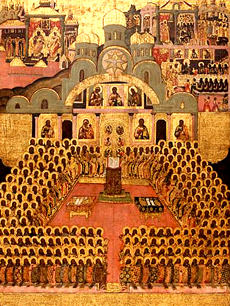 |
| Second Council of Nicaea |
In the masa of the early church, the artistic portrayal of biblical characters, or iconography, served to teach biblical lessons and church history to the illiterate masses.
Churches often displayed biblical scenes or depictions of saints’ lives, but charges of idolatry from Muslims (who opposed the depiction of the human form) and the Jews (citing the Torah’s prohibition against the worship of any graven image) served to bring about the imperial decrees to destroy any pictorial or symbolic representations of scenes from the scriptures or the saints.
Biblical passages about the nature, practice, and consequences of idolatry abound in Holy Writ; indeed, devotion to icons had risen in intensity among the Byzantines, as well as a great deal of religious superstition related to their use. Emperor Leo III (717–741), the Isaurian, believed the only hope of converting Muslims and Jews was to abandon the use of icons.
In 726 he issued an imperial decree ordering the destruction of icons and relics, and his successor, his son, Constantine V, upheld his father’s edict in 753. A synod at Hiereia met in 754 and upheld iconoclasm. The iconodules, or churchmen and monks defending the use of icons, fought against the destruction of the images, often at the cost of their lives.
Convoked at the behest of the empress Irene in 786, the imperial government called for the council to decide the issue. Though dominated by over 300 Byzantine clerics, Pope Hadrian I (772–795) sent two representatives to the gathering who carried with them a treatise from the pope justifying the veneration of images.
The first session, meeting at Constantinople, came under attack by soldiers committed to iconoclasm; therefore it was decided to move the meeting to Nicaea in Bithynia (now Inzik, Turkey), where the council opened on September 24, 787.
The council met for eight sessions conducted over a period of three weeks. Tarasius, patriarch of Constantinople, presided over the first seven sessions, and the empress Irene led the simpulan meeting of the council at Constantinople.
The first session dealt with the issue of what to do with the iconoclast bishops, many of whom attended the gathering. Once the wayward bishops recanted of their “error” and begged forgiveness from the conclave, the clerics received restoration among the ecclesiastical fellowship.
During the second session, the papal legates sent by the Holy See read aloud the letter sent by Pope Hadrian I to the assembly in which the pope urged the restoration of the icons. The third session, September 28 or 29, bishops who recanted their iconoclastic pronouncements received permission to take seats on the council.
The fourth session, held on October 1, consisted of readings of long passages from the Bible and the church fathers that favored the veneration of images, and the session closed after a decree was signed by all present that the participants were ready to receive in fellowship all those who would openly abandon the iconoclastic position.
During the fifth session, on October 4, the gathering heard the oral readings of the church fathers opposed to icon use, but the council chose not to read all of the anti-icon writings and voted in favor of image veneration.
The fifth session closed with the formal display of an image in the meeting place of the council. The sixth session, which met October 6, the iconoclastic decision of the council held at Hiereia in 753 received the formal condemnation.
The dogmatic decision of the council, read at the seventh and simpulan session at Nicaea on October 13, formalized the veneration of images. The simpulan session, led by the empress and her son at the Magnuara palace in Constantinople on October 23, resulted in the two monarchs and the clerics signing the Acta of the council making the canons decided upon by the gathering the law of the church and the Byzantine Empire.
In the end, the council promulgated 22 canons. The ninth canon demanded the surrender of writings against images, and the remaining canons consisted of matters related to clerical ethics, practice, and discipline.
The council did not end the controversy; it persisted for another generation, but it did provide for the formal recognition of icon veneration, defined as a matter of respect and honor, and not idol worship or pagan practice.

EmoticonEmoticon